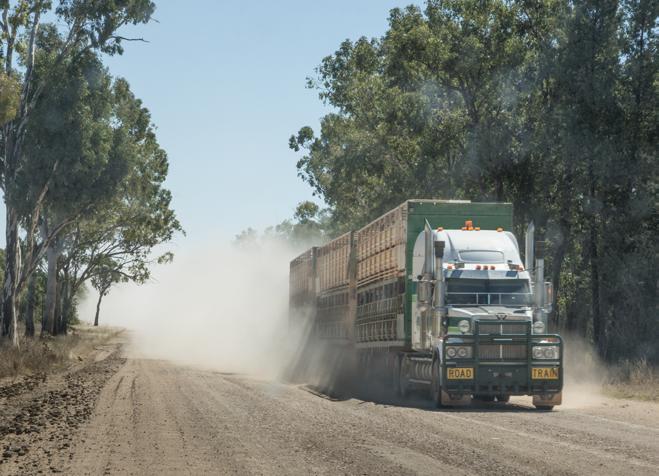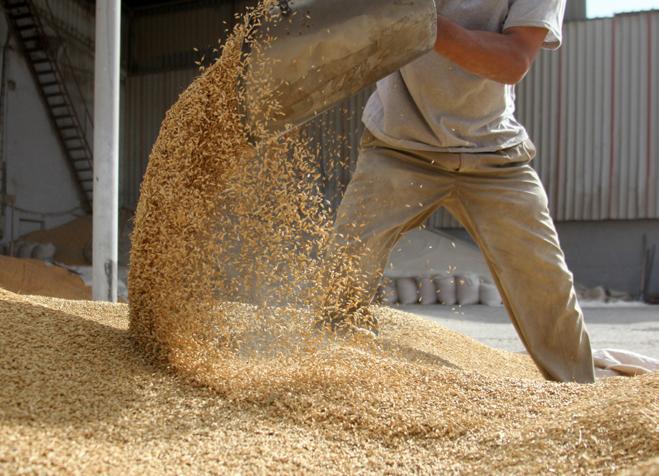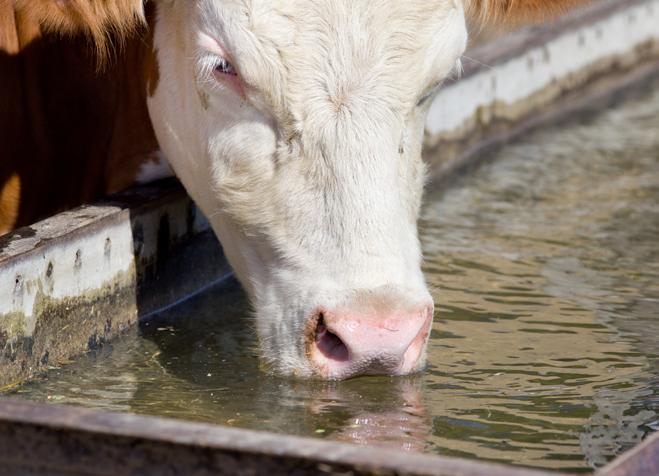
9 minute read
Chapter 3 – Biosecurity
CHAPTER 3.
BIOSECURITY
Biosecurity measures help the cattle industry maintain animal and human health. Work with your veterinarian to develop specific biosecurity measures for your operation. Consider the biological hazard, relative significance and risk of each potential biosecurity challenge. Examples of sources that might spread of disease into and/or across an operation include:
Potential sources of disease:


» Diseased animals » Animals recovered from disease but now are carriers » Clinically healthy animals but incubating disease » Vector-borne disease » Non-livestock animals » Wildlife and pests » Feral livestock » People who move between herds and their clothing, shoes, etc.

» Contact with inanimate objects including vehicles and equipment that move between herds.

» Feedstuffs, especially highrisk feedstuffs, which could be contaminated with feces.

» Impure water (surface drainage water, etc.).

» Aerosol transmission (wind) including aerosolized manure and dust.
The checklists below are meant to provide management guidelines for a variety of biosecurity concerns.
Best Management Practices for Strategic Vaccine Use
Have a written strategic vaccination plan for each operation. Know when and how to use the vaccines listed in the vaccination plan. Discuss the vaccination history of all cattle purchased before the cattle arrive.
Attempt to obtain the health history for the herds from which cattle are purchased. Attempt to obtain the health status of animals brought into the operation and demand a valid health certificate. When possible, ensure the herd veterinarian talks to the seller’s veterinarian prior to buying animals. Transport animals in clean vehicles. Have a disease control program for outside animals that could spread disease (e.g., rodents, etc.). Locate the loading area at the perimeter of the operation. Locate the dead animal pickup area so that rendering trucks do not contaminate the operation. Limit people’s access to cattle pens, feed mixing/storage areas, feed bunks, and cattle treatment areas. Keep a record of visitors to the operation.
Biosecurity Practices for Disease Containment
Provide a clean area for restraint, treatment, and isolation of sick cattle. Prevent cross-contamination of water, manure, feed, or equipment between groups with different health status. Have a plan to manage group size, age distribution, and animal flow to reduce risk of disease. Handle highest health status animals first (i.e., young calves, healthy older cattle), and sick animals last. Necropsy selected animals to verify the causes of death. Ensure a veterinarian collects blood samples from all cows that abort.
Biosecurity Practices for Sanitation
Clean contaminated vehicles and equipment before use around healthy cattle. Attempt to prevent manure contamination of feed and equipment. Immediately remedy any situation in which manure accidentally contaminates feed or water. Clean treatment, handling, and feeding equipment used on sick animals after each use. Attempt to prevent cross-contamination between healthy and sick or dead cattle. Regularly evaluate the activities on your operation to assess the potential for contaminating cattle. Use disinfectant products according to label instructions and for the correct pathogen.
Biosecurity Practices for Equipment
Use different equipment to feed and clean pens or clean and disinfect equipment between use. Never step in the feed bunk. Never leave manure-handling equipment in pens with different animal groups. Clean and disinfect contaminated vehicles and equipment before use around healthy cattle. Routinely clean and disinfect feeding equipment and cattle handling equipment Routinely clean and disinfect equipment used to medicate cattle. Routinely clean equipment washing areas.
Place cattle that use community pastures in performance evaluation centers. Control fence-line contact with neighboring cattle. Always buy cattle that have tested negative for Johne’s Disease. Know the biosecurity, vaccination, and testing program for herd(s) for replacement cattle. Quarantine new arrivals for 21-30 days before allowing them contact with your cattle. Design the quarantine area to prevent cross contamination between cattle.
Biosecurity Practices for Calf Management
Have a strategic vaccination and parasite control plan in place for all cattle. Keep newly introduced cattle off of pastures where manure that could pose a disease risk has been spread until risk can be confidently neutralized. Keep replacement cattle separate from other cattle for at least 21-30 days. Provide replacement cattle a separate source of water. Consult with a veterinarian annually about calf care. Ensure the calving area is clean and dry. Ensure all calves are born from cows that have tested negative for infectious diseases. Ensure all colostrum fed to calves comes from cows that have tested negative for diseases of concern in your herd. Ensure calves are permanently identified prior to any grouping.
Biosecurity Practices for Controlling Salmonella
Realize that visitors and employees can be infected with salmonella from cattle. Isolate sick cattle in hospital area and prevent cross contamination. Discuss proper antibiotic use with a veterinarian. Clean all instruments and equipment used on sick cattle after each use. Test purchased feed for salmonella. Restrict birds, cats, rodents, and stray animals from accessing cattle's feed and water. Do not allow rendering trucks to access feed or animal areas.
Understand persistently infected (PI) animals as they relate to BVD. Do not keep a PI calf as a replacement heifer. Commit to finding BVD PI cattle and removing them from herd. Discuss use of killed virus versus modified live virus vaccines for BVD with your veterinarian. Control fence-line contact with neighboring cattle.
Understand how Johne’s disease can impact your herd and how it is spread. If Johne’s is suspected, screen the whole herd using an antibody ELISA test (measures antibody in blood) and/or fecal culture. Work with your veterinarian to determine detection threshold for culling. Ensure replacement heifers (less than 24 months) are tested prior to introduction to the herd. Remove calves from cows testing positive. Implement a follow-up testing program for Johne’s and have have it reviewed with herd veterinarian.
Use caution when using needles or palpation sleeves on more than one animal. Avoid feeding colostrum to calves from cows testing positive to bovine leukemia virus. Test purchased cattle during quarantine.
Biosecurity Practices for Controlling Foot & Mouth Disease (FMD)*
Designate a Biosecurity Manager to write an operation-specific enhanced biosecurity plan with the assistance of a veterinarian. Ensure the Biosecurity Manager and essential personnel are trained in biosecurity measures to keep FMD out of the herd. Establish a line of separation (LOS) with controlled access points to protect cattle from movement of virus onto the operation. Establish a cleaning and disinfection station for all vehicles/equipment crossing the LOS. Ensure everyone crossing the LOS has showered, is wearing clean clothing and footwear, and signs the log book. Record all animal, semen, and embryo movement. Only accept animals, semen, and embryos from sources with documented biosecurity practices and that have no evidence of current or previous FMD infection. Develop contingency plans for interrupted animal movement (e.g., several weeks). Dispose of carcasses (i.e., normal mortalities) in a manner that prevents attraction of scavengers; the use of rendering trucks may be prohibited during an FMD outbreak. Dispose of manure in a manner that prevents exposure of animals and meets regulations. Establish control measures to minimize interaction between cattle and other animals (e.g., deer, feral pigs, rodents, dogs, cats, etc.). Ensure feedstuffs are delivered, stored, mixed, and fed in a manner that minimizes contamination and feed spills are cleaned up promptly to avoid attracting wildlife. * These practices are part of the Secure Beef Supply Plan for Continuity of Business during an FMD Outbreak. Producers are encouraged to write an enhanced biosecurity plan and be ready to implement it during an FMD outbreak. Controlling the spread of this highly-contagious animal disease involves stopping animal and animal product (i.e., cattle, pigs, sheep, goats, semen, embryos, manure) movement in the areas around infected animals. Once stopped, restarting movement will require a special permit issued by Regulatory Officials after a producer meets certain requirements, including enhanced biosecurity. The Secure Beef Supply (SBS)
Plan provides guidance for producers who have cattle with no evidence of FMD infection prepare to meet movement permit requirements. Visit the Secure Beef website for more information.
Evaluate ways to prevent fecal contamination of cattle's feed or oral cavity (e.g., ingestion). Avoid high-risk feed sources and protect feed supplies from fecal contamination. Observe septic leach fields and fix any broken pipes. Educate workers about the importance of personal hygiene near feedstuffs or feed bunks, water tanks, or pens where cattle could come in contact with tapeworm segments or eggs spread by infected humans.
Biosecurity Practices for Pest Control
Understand that rodents and birds may transmit disease and cause damage to equipment, including sensitive electrical connections. Consider employing a certified pesticide applicator or service. Read and follow all label directions for controlled products.
Biosecurity Practices for Water Contamination
Prioritize protecting cattle's water supply from contamination (e.g., manure, chemicals, etc.). Ensure everyone in the beef operation is on constant alert for practices that could cause contamination of the water supply. Report to the operation’s manager and address any suspected contamination of a water supply.
Pathogen Management
Pathogens, or microorganisms that can cause disease, can survive in environments for significant periods of time. However, when used properly, disinfectants can control the survival and transmission of various pathogens. The physiology of pathogens directs the best disinfectants to use against them. For example, some viruses are covered in an envelope or a membrane made of lipids and proteins. These envelopes make the viruses more easily compromised by disinfectants. Identifying the existing or potentially existing pathogens on an operation is the first step to determining how to manage them. The tables below display common cattle viruses and disinfectants that effectively manage different pathogens.
Cattle Viruses With and Without Viral Envelopes
Virus Enveloped Virus Enveloped Virus Enveloped
Bluetongue No BVD Yes BRSV Yes
Coronavirus (enteric and respiratory) Yes Cowpox Yes FMD No
Herpes 1 (IBR and IPV) Yes Herpes 2 (Mammallitis) Yes Leukemia Yes
Lumpy Skin Disease Yes Malignant Catarrhal Fever Yes Papilloma No
Papular Stomatitis Yes PI3 Yes Pseudocowpox Yes Rabies Yes Rotavirus No Vesicular Stomatitis Yes
Disinfectant Selection Table
Compound Chlorine 0.01-5%
Examples Clorox
Iodine iodophor 0.5-5%
Tincture/ Provodine
Chlorhexidine 0.05-0.5% Alcohol 70-95% Oxidizing 0.2-3% Phenol 0.2-3% Quaternary ammonium 0.1-2% Aldehyde 1-2%
Novalsan --- VikronS Lysol Roccal-D Wavicide
Bactericidal Good Good
Virucidal Very Good Good Very Good
Very Good Good Good Good Good
Good Good Fair Fair Very Good
Very Good
Enveloped viruses Yes Yes Yes Yes Yes Yes Yes Yes
Nonenveloped viruses Yes Yes No No Yes No No Yes
Bacterial spores Fair Fair Poor Fair Fair to Good Poor Poor Good
Fungicidal Good Good Fair to Good Fair Fair Good Fair Good
Effective in organic matter Poor Fair Fair Fair Poor Good Fair Good
Inactivated by soap Effective in hard water
Contact time (minutes) Residual activity No No & Yes No No No No Yes No
Yes No Yes Yes Yes Yes No Yes
5-30 10-30 5-10 10-30 10-30 10-30 10-30 10-60
Poor Poor Good Fair Poor Poor Fair Fair


